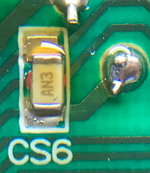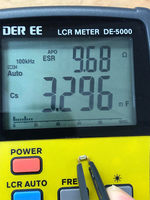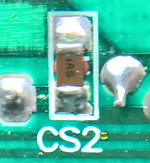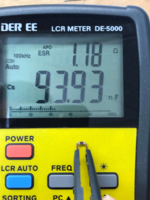I wish we had a schematic of the CC Analog board! But that doesn't exist outside Apple's internal archives. (You'd think will all the leaking that goes on, someone would have leaked those schematics by now!)
The web info on the Stereo Mod says to put the same capacitor on the CS5 pads as is used at CS6. Pretty funny too because none of those instructions state the capacitance or voltage specs! Well today I desoldered and then measured it...
View attachment 5375
View attachment 5376
So
at 100kHz, it measures
3.3nF. But at 120Hz, it measured about 3.5nF. That's why a schematic would have been helpful to know what the intended value should be. Even so, we know the marking on the capacitor at CS6 is
AN3. For the life of me, I cannot find a single photo of another cap with that marking, but I did find this...
It shows a table and how to use the table. They give an example of KA2 = 100pf (0.1nF). They say K=Kemet, and the "1" would be from the A, and the 2 zeros after the 1 would come from "2". Based on that, when pondering AN2, I can only guess A=AVX, and then we know N=3.3, and then 3 = "multiply by 1000". 3.3 x 1000 = 3300pF = 3.3nF. A table I found in a KEMET SMD Cap datasheet confirms that (when considering only the "N3" of "AN3")...
View attachment 5377
Next, I measured the body of CS6:
L = 3.2mm
W = 1.65mm
Which corresponds to 3216 (1206).
Small capacitance sizes in the low nF and pF range tend to use
C0G/NP0, so I will guess CS6 uses that dielectric. Even if it doesn't, C0G is by far better than X7R or lesser grade ceramic caps (temperature stable and no voltage bias issues).
But to order a cap on Mouser or Digikey, you also need to know the
Voltage &
Tolerance specs. That's where we need to guess (because we have no schematic), A higher voltage spec and smaller tolerance value are safest, but go too extreme and the part price gets a bit high. Pricing all the 1% to 5% tolerance parts between 50V and 100V, leads me to guess that p/n:
12061A332JAT2A might be best for
CS6 (5% tolerance, 100V). It's not going to be over 100V in that location, and 5% is a very tight tolerance.
Next, is the capacitor needed for the
CS1 pads. The info on the net says, "same cap as
CS2." I desoldered and measured CS2...
View attachment 5378
View attachment 5379
Marking is
IA5, which means I=manufacturer (who knows!), A5 = 100,000pF =
100nF = 0.1uF. This is a bypass cap, mostly likely an
X7R.
Choosing Voltage & Tolerance requires the same guesswork as with CS6, but in my case, since I have stock of Vishay p/n:
VJ1206Y104KXACW1BC (50V, 10% tolerance, body size 3216/1206), I will use that on the
CS1 pads.
I will comment on the other required parts when I have more time. I'm still in the middle of the SE Reloaded project filming, and after that I made promises to do a video on BlueSCSI and MacSD, but after that, I will do the Stereo mod.





